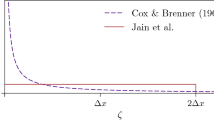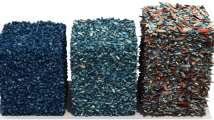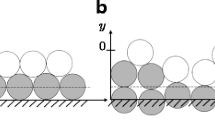Abstract
The loading conditions of pebbles in fluvial gravel deposits were studied with different degrees of preferred particle orientation. Sediments that are comprised of non-spherical particles often show a preferred particle orientation, due to dynamic sedimentation. Here, the impact of this effect on the loading conditions of the particles and its implication on particle breakage was investigated by using discrete element simulations in three dimensions. The numerical models are based on the size and shape distribution of pebbles from a natural gravel sample. In addition, the particle size in some of the models was chosen to be uniform, to study the influence of the particle size distribution on the loading condition. Fluvial pebbles, whose shapes can be at best approximated by ellipsoids, were efficiently simulated in the discrete element models by the use of clumps. The results show that a preferred orientation of approximate ellipsoidal sedimentary particles has only a minor effect on the number and the position of particle contacts but leads to a significant load transfer from the rim to the centre of the oblate sides of the ellipsoidal particles, in comparison to an assembly of arbitrarily oriented particles. The comparison of the different particle size models indicates that the influence of the particle size distribution on the loading condition is relatively low. The results have significant implications for the breakage rate of non-spherical particles in sediments under load.
Similar content being viewed by others
References
Arslan H., Baykal G., Sture S.: Analysis of the influence of crushing on the behavior of granular materials under shear. Granul. Matter 11(2), 87–97 (2009). doi:10.1007/s10035-009-0127-5
Cheng Y.P., Nakata Y., Bolton M.D.: Discrete element simulation of crushable soil. Geotechnique 53(7), 633–641 (2003)
Couroyer C., Ning Z., Ghadiri M.: Distinct element analysis of bulk crushing: Effect of particle properties and loading rate. Powder Technol. 109(1–3), 241–254 (2000)
Marketos G., Bolton M.D.: Compaction bands simulated in discrete element models. J. Struct. Geol. 31(5), 479–490 (2009). doi:10.1016/j.jsg.2009.03.002
Wang B.S., Chen Y., Wong T.F.: A discrete element model for the development of compaction localization in granular rock. J. Geophys. Res. Solid Earth 113(B03202), 1–17 (2008). doi:10.1029/2006jb004501
Tang C.A., Liu H.Y., Zhu W.C., Yang T.H., Li W.H., Song L., Lin P.: Numerical approach to particle breakage under different loading conditions. Powder Technol. 143–144, 130–143 (2004). doi:10.1016/j.powtec.2004.04.026
Tsoungui O., Vallet D., Charmet J.C.: Numerical model of crushing of grains inside two-dimensional granular materials. Powder Technol. 105(1–3), 190–198 (1999)
Gallagher J.J., Friedman M., Handin J., Sowers G.M.: Experimental studies relating to microfracture in sandstone. Tectonophysics 21(3), 203–247 (1974)
Antony S.J., Kuhn M.R.: Influence of particle shape on granular contact signatures and shear strength: new insights from simulations. Int. J. Solids Struct. 41(21), 5863–5870 (2004). doi:10.1016/j.ijsolstr.2004.05.067
Maeda K., Sakai H., Kondo A., Yamaguchi T., Fukuma M., Nukudani E.: Stress-chain based micromechanics of sand with grain shape effect. Granul. Matter 12(5), 499–505 (2010). doi:10.1007/s10035-010-0208-5
Matsushima T., Chang C.S.: Quantitative evaluation of the effect of irregularly shaped particles in sheared granular assemblies. Granul. Matter 13(3), 269–276 (2011). doi:10.1007/s10035-011-0263-6
Nouguier-Lehon C., Cambou B., Vincens E.: Influence of particle shape and angularity on the behaviour of granular materials: a numerical analysis. Int. J. Numer. Anal. Met. 27(14), 1207–1226 (2003). doi:10.1002/Nag.314
Massari F.: Upper-flow-regime stratification types on steep-face, coarse-grained, Gilbert-type progradational wedges (Pleistocene, southern Italy). J. Sediment. Res. 66(2), 364–375 (1996)
Sohn Y.K., Kim S.B., Hwang I.G., Bahk J.J., Choe M.Y., Chough S.K.: Characteristics and depositional processes of large-scale gravelly Gilbert-type foresets in the Miocene Doumsan fan delta, Pohang Basin, SE Korea. J. Sediment Res. 67(1), 130–141 (1997). doi:10.1306/d4268513-2b26-11d7-8648000102c1865d
Exner U., Grasemann B.: Deformation bands in gravels: displacement gradients and heterogeneous strain. J. Geol. Soc. Lond. 167(5), 905–913 (2010). doi:10.1144/0016-76492009-076
Spahic D., Exner U., Behm M., Grasemann B., Haring A., Pretsch H.: Listric versus planar normal fault geometry: an example from the Eisenstadt-Sopron Basin (E Austria). Int. J. Earth Sci. 100(7), 1685–1695 (2011). doi:10.1007/s00531-010-0583-5
Cundall P.A., Strack O.D.L.: Discrete numerical-model for granular assemblies. Geotechnique 29(1), 47–65 (1979)
McDowell G.R., Ferellec J.F.: A method to model realistic particle shape and inertia in DEM. Granul. Matter 12(5), 459–467 (2010). doi:10.1007/s10035-010-0205-8
Potyondy D.O., Cundall P.A.: A bonded-particle model for rock. Int. J. Rock Mech. Min. Sci. 41(8), 1329–1364 (2004)
Hazzard J.F., Young R.P., Maxwell S.C.: Micromechanical modeling of cracking and failure in brittle rocks. J. Geophys. Res. Solid Earth 105(B7), 16683–16697 (2000)
Ferellec J.F., McDowell G.R.: A method to model realistic particle shape and inertia in DEM. Granul. Matter 12(5), 459–467 (2010). doi:10.1007/s10035-010-0205-8
Tuitz C., Exner U., Frehner M., Grasemann B.: The impact of ellipsoidal particle shape on pebble breakage in gravel. Int. J. Rock Mech. Min. Sci. 54, 70–79 (2012). doi:10.1016/j.ijrmms.2012.05.018
Klette, R., Rosenfeld, A.: Digital Geometry, pp. 287–290. Elsevier, Amsterdam (2004)
Tee, G.J.: Surface area of ellipsoid segment. University of Auckland, Department of Mathematics. http://www.math.auckland.ac.nz/Research/Reports/Series/539.pdf (2005) Accessed 9 January 2012
Lu M., McDowell G.: The importance of modelling ballast particle shape in the discrete element method. Granul. Matter 9(1), 69–80 (2007). doi:10.1007/s10035-006-0021-3
Radjai F., Wolf D.E., Jean M., Moreau J.J.: Bimodal character of stress transmission in granular packings. Phys. Rev. Lett. 80(1), 61–64 (1998)
Peters J.F., Muthuswamy M., Wibowo J., Tordesillas A.: Characterization of force chains in granular material. Phys. Rev. E 72(4), 041307 (2005). doi:10.1103/Physreve.72.041307
Beard D.C., Weyl P.K.: Influence of texture on porosity and permeability of unconsolidated sand. Am. Assoc. Petr. Geol. B 57(2), 349–369 (1973)
Kondolf G.M., Adhikari A.: Weibull vs. lognormal distributions for fluvial gravels. J. Sediment. Res. 70(3), 456–460 (2000)
Author information
Authors and Affiliations
Corresponding author
Rights and permissions
About this article
Cite this article
Tuitz, C., Exner, U., Preh, A. et al. The influence of particle orientation on the loading condition of pebbles in fluvial gravel. Granular Matter 14, 639–649 (2012). https://doi.org/10.1007/s10035-012-0365-9
Received:
Published:
Issue Date:
DOI: https://doi.org/10.1007/s10035-012-0365-9




